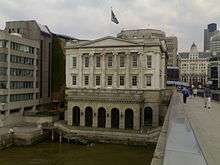Fishmongers' Hall

Fishmongers' Hall is a Grade II* listed building on London Bridge, London EC4.[1] It is the headquarters of the Worshipful Company of Fishmongers, one of the livery companies of the City of London.
The Company's hall in the City of London is known as Fishmongers' Hall (sometimes shortened in common parlance to Fish Hall); its earliest recorded hall was built in 1310. A new hall, on the present site, was bequeathed to the Company in 1434. Together with 43 other Livery halls, this one was destroyed in the Great Fire of London in 1666 and a replacement hall designed by the architect Edward Jerman opened in 1671. This hall by Jerman was demolished to facilitate the construction of the new London Bridge in 1827. The Fishmongers' next hall was designed by Henry Roberts (although his assistant, later the celebrated Sir Gilbert Scott, made the drawings) and built by William Cubitt & Company, opening in 1834.[2] After severe bomb damage during the Blitz, Fishmongers' Hall was restored by Austen Hall (of Whinney, Son & Austen Hall) and reopened in 1951.
Fishmongers' Hall contains many treasures, including the dagger with which Lord Mayor Walworth killed Wat Tyler in 1381, the 1955 portrait of Queen Elizabeth II by Piero Annigoni,[3] an impressive collection of 17th and 18th-century silver, a priceless embroidered 15th-century funeral pall, two portraits by George Romney and river scenes painted by Samuel Scott. The Hall is situated in Bridge Ward on London Bridge.
References
- ↑ Historic England. "Fishmongers' Hall (1359203)". National Heritage List for England. Retrieved 17 June 2015.
- ↑ "William Cubitt & Co". Scottish Architects. Retrieved 4 June 2012.
- ↑ "News Release: Annigoni's great 1950s painting of the Queen goes on show for the first time in 26 years in Diamond Jubilee Exhibition". National Portrait Gallery. Retrieved 12 June 2012.
External links
| Wikimedia Commons has media related to Fishmongers' Hall, London. |
Coordinates: 51°30′34″N 0°05′16″W / 51.50939°N 0.08764°W